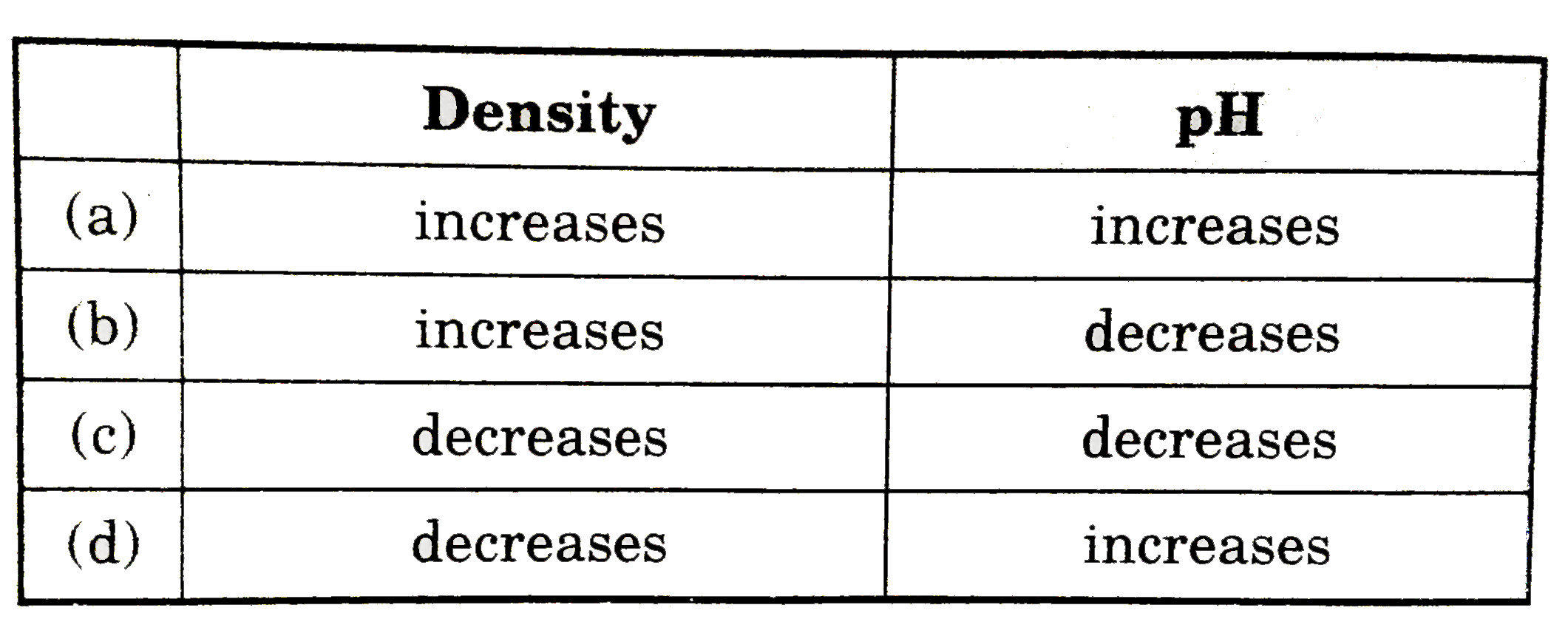The electrode reactions for charging of a leas storage battery are :
PbSO4+2e−=Pb+SO2−4
PbSO4+2H2O=PbO2+SO2−4+4H+2e−
The electrolyte in the battery is an aqueous solution of sulphuric acid. Before charging, the specific gravity of the liquid was found to be 1.11 (15.7% H2SO4 by weight). After charging for 100 hours, the sp. gr. of the liquid was found to be 1.28 (36.9% H2SO4 by wr.). If the battery contained two litres of the liquid, calculate the average current used for charging the battery.
NB. (e−) denotes electrons. Assume that the volume of the battery liquid remained constant during charging. 1 faraday = 96500 coulombs.
To calculate the average current used for charging the lead storage battery, we will follow these steps:
Step 1: Calculate the mass of H₂SO₄ before charging
Given:
- Specific gravity before charging = 1.11
- Percentage of H₂SO₄ by weight = 15.7%
- Volume of the liquid = 2 liters = 2000 mL
First, we need to find the mass of the solution before charging:
Mass of solution=Volume×Specific Gravity=2000mL×1.11g/mL=2220g
Next, calculate the mass of H₂SO₄ in this solution:
Mass of H₂SO₄=Mass of solution×(Percentage of H₂SO₄100)=2220g×(15.7100)=348.54g
Step 2: Calculate the mass of H₂SO₄ after charging
Given:
- Specific gravity after charging = 1.28
- Percentage of H₂SO₄ by weight = 36.9%
Calculate the mass of the solution after charging:
Mass of solution=2000mL×1.28g/mL=2560g
Now, calculate the mass of H₂SO₄ in this solution:
Mass of H₂SO₄=2560g×(36.9100)=944.64g
Step 3: Calculate the change in mass of H₂SO₄
Δmass of H₂SO₄=Mass after charging−Mass before charging=944.64g−348.54g=596.1g
Step 4: Calculate moles of H₂SO₄ produced
Molar mass of H₂SO₄ = 98 g/mol
Moles of H₂SO₄=Δmass of H₂SO₄Molar mass of H₂SO₄=596.1g98g/mol=6.08mol
Step 5: Calculate the total charge (in coulombs)
According to Faraday's laws of electrolysis, 1 mole of H₂SO₄ produces 2 moles of electrons (since each H₂SO₄ produces 2 PbSO₄). Therefore:
Total moles of electrons=2×Moles of H₂SO₄=2×6.08mol=12.16mol
Using Faraday's constant (1 Faraday = 96500 C):
Total charge=Total moles of electrons×96500C/mol=12.16mol×96500C/mol=1177312C
Step 6: Calculate the average current
Charging time = 100 hours = 100 × 3600 seconds = 360000 seconds
Average current=Total chargeTime=1177312C360000s≈3.27A
Final Answer:
The average current used for charging the battery is approximately 3.27 A.
---
Given:
- Specific gravity before charging = 1.11
- Percentage of H₂SO₄ by weight = 15.7%
- Volume of the liquid = 2 liters = 2000 mL
Mass of solution=Volume×Specific Gravity=2000mL×1.11g/mL=2220g
Mass of H₂SO₄=Mass of solution×(Percentage of H₂SO₄100)=2220g×(15.7100)=348.54g
Given:
- Specific gravity after charging = 1.28
- Percentage of H₂SO₄ by weight = 36.9%
Mass of solution=2000mL×1.28g/mL=2560g
Mass of H₂SO₄=2560g×(36.9100)=944.64g
Δmass of H₂SO₄=Mass after charging−Mass before charging=944.64g−348.54g=596.1g
Molar mass of H₂SO₄ = 98 g/mol
Moles of H₂SO₄=Δmass of H₂SO₄Molar mass of H₂SO₄=596.1g98g/mol=6.08mol
According to Faraday's laws of electrolysis, 1 mole of H₂SO₄ produces 2 moles of electrons (since each H₂SO₄ produces 2 PbSO₄). Therefore:
Total moles of electrons=2×Moles of H₂SO₄=2×6.08mol=12.16mol
Total charge=Total moles of electrons×96500C/mol=12.16mol×96500C/mol=1177312C
Charging time = 100 hours = 100 × 3600 seconds = 360000 seconds
Average current=Total chargeTime=1177312C360000s≈3.27A
The average current used for charging the battery is approximately 3.27 A.
Topper's Solved these Questions
- BOOK - RC MUKHERJEECHAPTER - ELECTROLYSIS AND ELECTROLYTIC CONDUCTANCEEXERCISE - Examples On Conductance13videos
ELECTROLYSIS AND ELECTROLYTIC CONDUCTANCE
- BOOK - RC MUKHERJEECHAPTER - ELECTROLYSIS AND ELECTROLYTIC CONDUCTANCEEXERCISE - Problems47videos
ELECTROLYSIS AND ELECTROLYTIC CONDUCTANCE
- BOOK - RC MUKHERJEECHAPTER - DILUTE SOLUTION AND COLLIGATIVE PROPERTIESEXERCISE - Objective problems36videos
DILUTE SOLUTION AND COLLIGATIVE PROPERTIES
- BOOK - RC MUKHERJEECHAPTER - ELECTROMOTIVE FORCE EXERCISE - EXERCISE1videos
ELECTROMOTIVE FORCE
Similar Questions
Knowledge Check
- Question 1 - Select One
The electrode reactions for charging of a lead battery are
PbSO4+2e−→SO2−4+Pb
PbSO4+2H2O→PbO2+SO2−4+4H++2e−
The electrolyte in the battery is an aqueous solution of sulphuric acid after the battery has been charged.AThe sulphuric acid will be more concentratedBThe sulphuric acid will be less concentratedCThe concentration of sulphuric acid will be unchangedDSulphuric acid will have been completely decomposed - Question 2 - Select One
The electrode reactions for charging of a lead battery are :
PbSO4+2e→Pb+SO2−4
PbSO4+2H2O→PbO2+SO2−4+4H++2e
The electrolyte in the battery is an aqueous solution of H2SO4. After this battery has been charged:Athe sulphuric acid will be more concentratedBthe sulphuric acid will be less concentratedCthe concentration of H2SO4 will be unchangedDH2SO4 will have been completely decomposed - Question 3 - Select One
Pb/PbSO4_((s)),SO−24(aq)
Pb(s)+SO−24⇔PbSO4(s)+?Ae−B3e−C2e−Dno electron
Assertion : Reverse current flows in charging of lead storage battery:
Reason : During charging PbSO4 convery into Pb and PbO2View SolutionThe solution of sulphuric acid contains 80% by weight H2SO4. Specific gravity of this solution is 1.71. Its normality is about
View SolutionPb(NO3)2+H2SO4→PbSO4⏐↓+2HNO3
View SolutionWhich of the processes happen during the discharging of a lead storage battery?
(P) H2(g) is produced
(Q)PbO2 is converted to PbSO4
(R ) The density of the electrolyte solution decreases.View SolutionThe overall reaction for the lead storage batter when it discharges is:
Pb(s)+PbO2(s)+4H+(aq)+2SO94)2−(aq)→2PbSO4(s)+2H2O(l)
(P) PbSO_(4) is formed only at the cathode.
(Q) The density of the solution decreases.
Which statements correctly describes the battery as its discharges?View Solution


